EFFICIENCY INDICATORS
COST PER PASSENGER KILOMETRE
This effectiveness indicator measures the cost efficiency of providing passenger services, expressed as the cost of carrying one passenger one kilometre.
Passenger kilometres are currently based on the zonal distribution of passenger trips and an assumed average trip length for each zone.
The indicator measures the cost efficiency of the services, i.e. the trend in the cost of carrying one passenger over one kilometre. A declining trend indicates that the resources used to provide the services are being utilised in a cost efficient manner.
Transperth Train Services
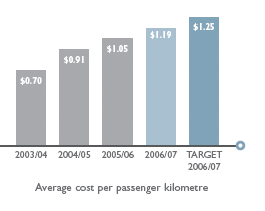
The 2006/07 result was better than target for the year due to passenger kilometres being 3.1% above target and total costs (which include expenditure associated with SSR) being $11.2 million below budget.
The average cost in 2006/07 was higher than in 2005/06 in spite of an increase of 9.2% in passenger kilometres. This was due to total costs increasing by 22.9% from $262.2 million in 2005/06 to $322.3 million in 2006/07. In preparation for the Southern Suburbs Railway opening in 2007/08, expenditure for 2006/07 was higher than 2005/06 on account of:
- recruitment of transit officers, drivers and customer service staff for Mandurah Line;
- provision of security services for the new SSR stations;
- set-up of depots and offices on Mandurah Line; and
- an increase in capital user charge due to the New MetroRail (NMR) debt being funded by equity offset by a decrease in interest charges following the repayment of the NMR debt in September 2006.
The increase in passenger kilometres was due to the following:
- an increase of 8% in initial boardings; and
- the use of a more accurate average trip length for the school trip (50 cent fare) of around 11.3km estimated from SmartRider boardings data in 2006/07. Previously the average school trip length had been assumed at 10 km. The new average trip length was used in the calculation and therefore contributed to the increase in train passenger kilometres.
Transperth Bus Services
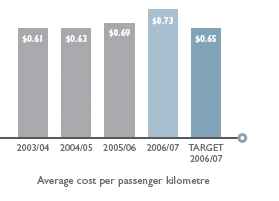
In 2006/07 the average cost per passenger kilometre was higher than the target for 2006/07 and the 2005/06 actual. That was due to a reduction of 3.7% in passenger kilometres between 2005/06 and 2006/07 while total costs increased by just 1.1% from $251.2 million to $254 million over the same period.
The decline in passenger kilometres was due to the change in the relative share of initial boardings accounted for by concession passengers and students paying the student fare of 50 cents during the school year.
In 2005/06, concession passengers on the bus system accounted for 62.7% of initial boardings and their average trip length was 8.8 kilometres. Students paying the 50 cent fare accounted for 8.8% of initial boardings and their average trip length was assumed at 8.5 kilometres in the absence of ticketing and survey data.
In 2006/07, the share of concession passengers in initial boardings fell to 55.7% and their average trip length fell to 8.4 kilometres. The student share in initial boardings increased to 13.1% while the average trip length for the school trip fell to 7.1 kilometres. This reduction in the average school trip length was based on boardings data from the SmartRider ticketing system which became available in 2006/07.
Transperth Ferry Services
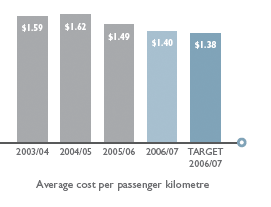
The result in 2006/07 was marginally higher than the target but significantly lower than 2005/06.
In 2006/07, while total boardings and passenger kilometres both exceeded target by 4.1% and 9.6% respectively, total costs exceeded the budget by 10.7%. As a result, the average cost for 2006/07 was higher than target. The increase in total costs was due to higher operating costs.
The average cost per passenger kilometres in 2006/07 fell by 6% compared to 2005/06 even though total costs increased by 4.2% from $734,000 to $765,000. The average cost was lower in 2006/07 due to the increase of 11.1% in passenger kilometres as a result of the 8.3% increase in initial boardings.
Transwa Rail Services

The average cost per passenger kilometre for 2006/07 exceeded target by 15.6% due to the increase in expenditure for the maintenance of Australind and Prospector trains.
Transwa Road Coach Services
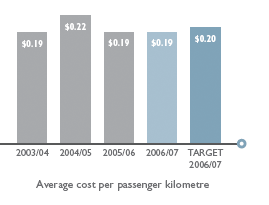
The average cost was slightly lower than target due to a reduction in passenger kilometres as a result of lower patronage.
Regional School Bus Services
The cost efficiency measure for school bus services measures the cost of funding student place kilometres provided to meet student requirements.
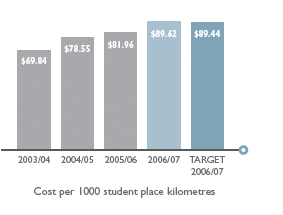
The 2006/07 results was slightly higher than target and the variance was not material. However, when compared to 2005/06 actual, the cost for 2006/07 was higher due to:
- the reduction in place kilometres from 847,082,000 in 2005/06 to 806,261,000 in 2006/07, partly due to the decrease in the actual number of service days from 189 in 2005/06 to 181 in 2006/07;
- change in transfer of overhead expenditure to a full cost recovery method in 2006/07; and
- additional costs in respect of the implementation of seatbelts on government contracted school buses in accordance with government policy.



